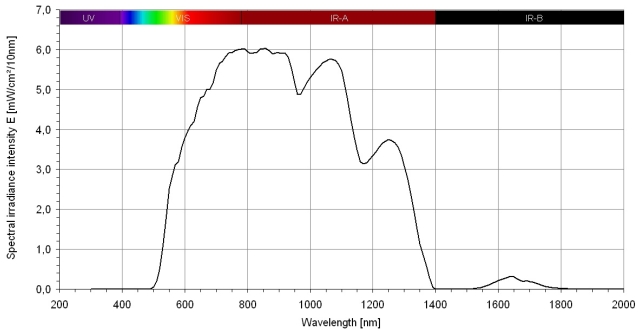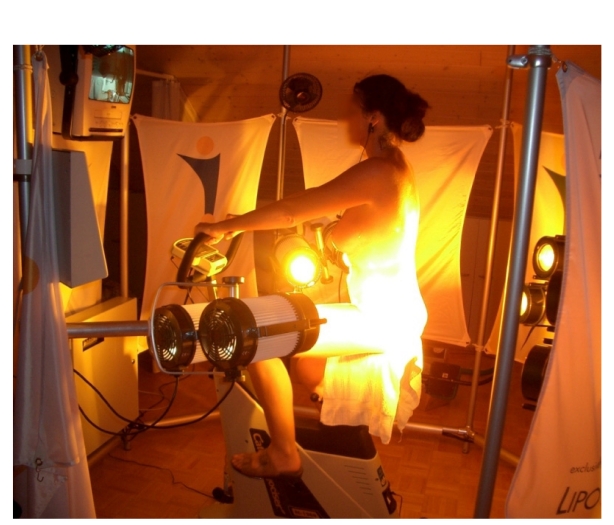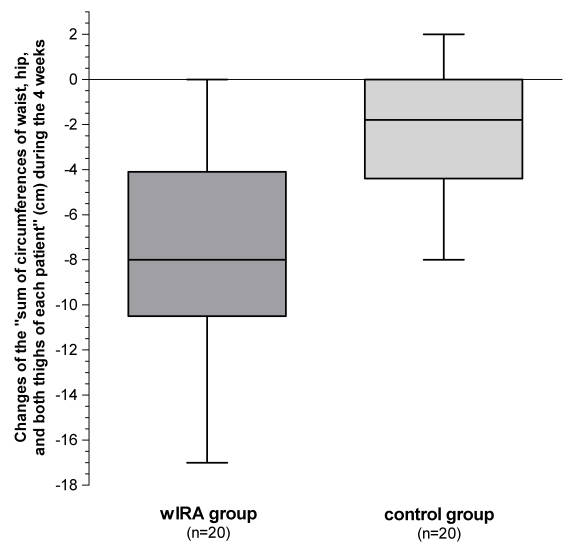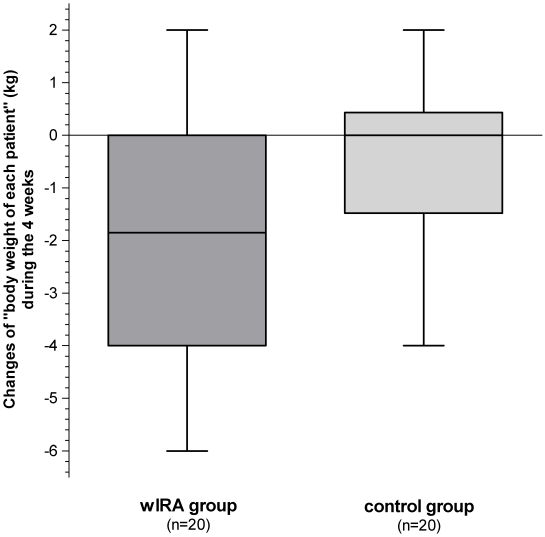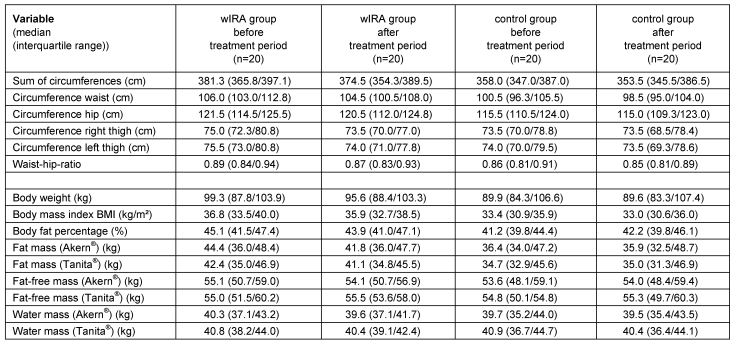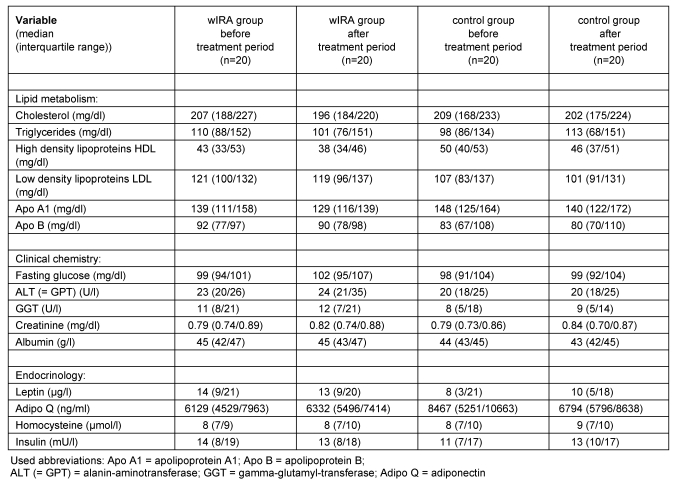Abstract
Aim of the study: Investigation, whether water-filtered infrared-A (wIRA) irradiation during moderate bicycle ergometer endurance exercise has effects especially on local fat reduction and on weight reduction beyond the effects of ergometer exercise alone.
Methods: Randomised controlled study with 40 obese females (BMI 30-40 (median: 34.5), body weight 76-125 (median: 94.9) kg, age 20-40 (median: 35.5) years, isocaloric nutrition), 20 in the wIRA group and 20 in the control group. In both groups each participant performed 3 times per week over 4 weeks for 45 minutes bicycle ergometer endurance exercise with a constant load according to a lactate level of 2 mmol/l (aerobic endurance load, as determined before the intervention period). In the wIRA group in addition large parts of the body (including waist, hip, and thighs) were irradiated during all ergometries of the intervention period with visible light and a predominant part of water-filtered infrared-A (wIRA), using the irradiation unit “Hydrosun® 6000” with 10 wIRA radiators (Hydrosun® Medizintechnik, Müllheim, Germany, radiator type 500, 4 mm water cuvette, yellow filter, water-filtered spectrum 500-1400 nm) around a speed independent bicycle ergometer.
Main variable of interest: change of “the sum of circumferences of waist, hip, and both thighs of each patient” over the intervention period (4 weeks). Additional variables of interest: body weight, body mass index BMI, body fat percentage, fat mass, fat-free mass, water mass (analysis of body composition by tetrapolar bioimpedance analysis), assessment of an arteriosclerotic risk profile by blood investigation of variables of lipid metabolism (cholesterol, triglycerides, high density lipoproteins HDL, low density lipoproteins LDL, apolipoprotein A1, apolipoprotein B), clinical chemistry (fasting glucose, alanin-aminotransferase ALT (= glutamyl pyruvic transaminase GPT), gamma-glutamyl-transferase GGT, creatinine, albumin), endocrinology (leptin, adiponectin (= adipo Q), homocysteine, insulin). All variables were at least measured before and after the intervention period. Ergometry (ECG, blood pressure behaviour, lactate curve with power at 2, 3 and 4 mmol/l) before the intervention period. In addition: nutrition training ahead of and during the intervention period with a nutrition protocol over one week for assessment of the daily energy intake; calculation of basic metabolic rate and total energy requirement. Assessment of undesired effects.
Only methods of non-parametric statistics were used, both descriptive (median, percentiles of 25 and 75 (= interquartile range), minimum, maximum) and confirmatory (two-sided Mann-Whitney U test for unpaired samples for the only one main variable of interest). Total error probability: .05 (5%). An intention to treat analysis ITT with last observed carry forward method was used preferably (presented results) and in addition an on treatment analysis OT. Only 2 (treatment group) and 4 (control group) drop-outs occurred (mostly due to lack of time).
Results: The “sum of circumferences of waist, hip, and both thighs of each patient” decreased during the 4 weeks significantly more (p<.001) in the wIRA group than in the control group: medians and interquartile ranges: -8.0 cm (-10.5 cm/-4.1 cm) vs. -1.8 cm (-4.4 cm/0.0 cm).
As well “body weight of each patient” decreased during the 4 weeks markedly more in the wIRA group than in the control group: medians and interquartile ranges: -1.9 kg (-4.0 kg/0.0 kg) vs. 0.0 kg (-1.5 kg/+0.4 kg); median of body weight changed from 99.3 kg to 95.6 kg (wIRA) vs. 89.9 kg to 89.6 kg (control). A similar effect showed the body mass index BMI.
Blood variables of interest remained unchanged or showed some slight improvements during the treatment period, concerning most variables with no obvious differences between the two groups; insulin showed a slight trend to decrease in the wIRA group and to increase in the control group.
Undesired effects of the treatment were not seen.
Discussion: The results of the study suggest, that wIRA – during moderate bicycle ergometer endurance exercise as lipolytic stimulus – increases local lipolysis with a local fat reduction (thighs) in the otherwise bradytrophic fatty tissue. The presumably underlying mechanisms of wIRA have already been proven: wIRA acts both by thermal effects and by non-thermal effects. Thermal effects of wIRA are the generation of a therapeutic field of warmth with the increase of tissue temperature, tissue oxygen partial pressure, and tissue blood flow, and by this regional metabolism. As fatty tissue normally has a slow metabolism (bradytrophic and hypothermic tissue) with a low rate of lipolysis, wIRA can increase lipolysis in fatty tissue and the mobilized fats are burned in musculature during the ergometer exercise.
Conclusion: The results of the study indicate, that wIRA irradiation during moderate ergometer endurance exercise can be used – in combination with an appropriate nutrition – to improve body composition, especially local fat distribution, and the reduction of fat and body weight in obese persons.
Keywords: water-filtered infrared-A (wIRA), weight reduction, local fat reduction, bicycle ergometer endurance exercise, lipolysis, randomised controlled study, intervention trial, body weight, body mass index BMI, analysis of body composition, tetrapolar bioimpedance analysis, lactate, lipid metabolism, cholesterol, triglycerides, high density lipoproteins HDL, low density lipoproteins LDL
Abstract
Ziel der Studie: Untersuchung, ob Bestrahlung mit wassergefiltertem Infrarot A (wIRA) während moderater Fußkurbelergometerausdauerbelastung Wirkungen insbesondere auf die lokale Fettabnahme und auf die Gewichtsabnahme hat, die über die Wirkungen der Ergometerbelastung allein hinausgehen.
Methoden: Randomisierte kontrollierte Untersuchung mit 40 adipösen Frauen (BMI 30-40 (Median: 34,5), Körpergewicht 76-125 (Median: 94,9) kg, Alter 20-40 (Median: 35,5) Jahre, isokalorische Ernährung), 20 in der wIRA-Gruppe und 20 in der Kontrollgruppe. In beiden Gruppen führte jede Teilnehmerin dreimal pro Woche über 4 Wochen für 45 Minuten eine Fußkurbelergometerausdauerbelastung mit einer konstanten Leistung durch, die einer Laktatkonzentration von 2 mmol/l entsprach (aerobe Ausdauerbelastung, wie sie vor der Interventionsperiode bestimmt wurde). In der wIRA-Gruppe wurden außerdem große Teile des Körpers (einschließlich Taille, Hüfte und Oberschenkel) während aller Ergometrien der Interventionsperiode mit sichtbarem Licht und einem überwiegenden Teil von wassergefiltertem Infrarot A (wIRA) bestrahlt, wobei die Bestrahlungseinheit "Hydrosun® 6000" mit 10 wIRA-Strahlern (Hydrosun® Medizintechnik, Müllheim, Deutschland, Strahlertyp 500, 4 mm Wasserküvette, Gelbfilter, wassergefiltertes Spektrum 500-1400 nm) um ein geschwindigkeitsunabhängiges Fußkurbelergometer herum verwendet wurde.
Hauptzielvariable: Änderung "der Summe der Umfänge von Taille, Hüfte und beiden Oberschenkeln von jedem Patienten" in der Interventionsperiode (4 Wochen). Zusätzliche Zielvariablen: Körpergewicht, Körpermasseindex BMI, Körperfettprozentsatz, Fettmasse, fettfreie Masse, Wassermasse (Analyse der Körperzusammensetzung mittels tetrapolarer Bioimpedanzanalyse), Erhebung eines Arteriosklerose-Risikoprofils mittels Blutuntersuchung von Variablen des Fettstoffwechsels (Cholesterin, Triglyzeride, High-density-Lipoproteine HDL, Low-density-Lipoproteine LDL, Apolipoprotein A1, Apolipoprotein B), klinischer Chemie (Nüchternblutzucker, Alanin-Aminotransferase ALT (= Glutamat-Pyruvat-Transaminase GPT), Gamma-Glutamyl-Transferase GGT, Kreatinin, Albumin), Endokrinologie (Leptin, Adiponectin (= Adipo Q), Homozystein, Insulin). Alle Variablen wurden mindestens vor und nach der Interventionsperiode bestimmt. Ergometrie (EKG, Blutdruckverhalten, Laktatkurve mit Leistung bei 2, 3 und 4 mmol/l) vor der Interventionsperiode. Außerdem: Ernährungsberatung vor und während der Interventionsperiode mit einem Ernährungsprotokoll über eine Woche zum Erfassen der täglichen Energiezufuhr; Berechnung des Grundstoffwechsels und des Gesamtenergiebedarfs. Erhebung von unerwünschten Wirkungen.
Es wurden nur Methoden nicht-parametrischer Statistik verwendet, sowohl deskriptiv (Median, 25%- und 75%-Perzentilen (= Interquartilspanne), Minimum, Maximum) als auch konfirmatorisch (zweiseitiger Mann-Whitney-U-Test für ungepaarte Stichproben für die einzige Hauptzielvariable). Gesamtirrtumswahrscheinlichkeit: 0,05 (5%). Eine Intention-to-treat-Analyse ITT mit Last-observed-carry-forward-Methode wurde vorzugsweise verwendet (dargestellte Ergebnisse) und außerdem eine On-Treatment-Analyse OT. Es traten nur 2 (Therapiegruppe) und 4 (Kontrollgruppe) Dropouts auf (hauptsächlich aufgrund Zeitmangels).
Ergebnisse: Die "Summe der Umfänge von Taille, Hüfte und beiden Oberschenkeln von jedem Patienten" verminderte sich während der 4 Wochen signifikant mehr (p<0,001) in der wIRA-Gruppe als in der Kontrollgruppe: Mediane und Interquartilspannen: -8,0 cm (-10,5 cm/-4,1 cm) vs. -1,8 cm (-4,4 cm/0,0 cm).
Auch nahm das "Körpergewicht jedes Patienten" während der 4 Wochen in der wIRA-Gruppe deutlich mehr als in der Kontrollgruppe ab: Mediane und Interquartilspannen: -1,9 kg (-4,0 kg/0,0 kg) vs. 0,0 kg (-1,5 kg/+0,4 kg); der Median des Körpergewichts veränderte sich von 99,3 kg auf 95,6 kg (wIRA) vs. von 89,9 kg auf 89,6 kg (Kontrolle). Einen ähnlichen Effekt zeigte der Körpermasseindex BMI.
Die Blutzielvariablen blieben unverändert oder zeigten einige leichte Verbesserungen während der Therapiephase, wobei die meisten Variablen keine offensichtlichen Unterschiede zwischen den zwei Gruppen zeigten; das Insulin zeigte einen leichten Trend, in der wIRA-Gruppe abzunehmen und in der Kontrollgruppe zuzunehmen.
Es wurden keine unerwünschten Wirkungen der Therapie beobachtet.
Diskussion: Die Ergebnisse der Studie legen nahe, dass wIRA – während moderater Fußkurbelergometerausdauerbelastung als lipolytischem Reiz – die lokale Lipolyse mit einer lokalen Fettabnahme (Oberschenkel) in dem sonst bradytrophen Fettgewebe steigert. Die vermutlich zugrundeliegenden Mechanismen von wIRA wurden schon nachgewiesen: wIRA wirkt sowohl thermisch als auch nicht-thermisch. Thermische Wirkungen von wIRA sind die Erzeugung eines therapeutischen Wärmefelds mit Zunahme von Gewebetemperatur, Gewebesauerstoffpartialdruck und Gewebedurchblutung und dadurch vom regionalen Stoffwechsel. Da Fettgewebe normalerweise einen langsamen Stoffwechsel (bradytrophes und hypothermes Gewebe) mit einer niedrigen Lipolyserate hat, kann wIRA die Lipolyse im Fettgewebe steigern, und die mobilisierten Fette werden in der Muskulatur während der Ergometerbelastung verbrannt.
Folgerung: Die Ergebnisse der Studie zeigen, daß wIRA-Bestrahlung während moderater Ergometerausdauerbelastung in Verbindung mit einer angemessenen Ernährung verwendet werden kann, um die Körperzusammensetzung, insbesondere die lokale Fettverteilung, und die Abnahme von Fett und Körpergewicht bei adipösen Personen zu verbessern.
Introduction
Nowadays, the ubiquity of obesity among the population of Europe and the USA presents an ever increasing problem to the medical community from the point of prevention. A huge part of the population of both sexes through all ages in Germany, 50% of the adults and 20% of the teenagers, must be judged to be overweight. Moreover, unfavorable regional distributions of the body fat – with or without a global obesity – represent an additional esthetic and psychological problem. A normalization of overweight is today a generally accepted target of a health oriented lifestyle. A combination of physical activity and changes in nutrition and behavior is useful and necessary to reach a normalization of overweight and a good fitness [1], [2], [3], [4], [5], [6], [7], [8], [9], [10], [11], [12], [13]. As 1 kg fat is equivalent to approximately 37,300 kJ and 1 kg fatty tissue to approximately 28,700 kJ and as fatty tissue as bradytrophic and hypothermic tissue has a slow metabolism, natural supporting procedures without drugs to reach a normal weight are worth while to be considered.
Water-filtered infrared-A (wIRA) irradiation (spectrum given in Figure 1 (Fig. 1)) is a scientifically proven procedure with a high energy transfer into tissue without irritating or overheating the skin, similar to sun heat radiation in moderate climatic zones, which is filtered by water vapour in the atmosphere [14]. wIRA – which already has been shown e.g. to improve wound healing in acute and chronic wounds [15], [16], [17], [18], [19], [20], the therapy of warts [14] and of actinic keratosis [21], [22], the body temperature in neonates [23], the regeneration after physical activity [24] (without undesired effects on muscle force and elasticity [25], [26]), and to reduce pain in a variety of diseases [27], [15], [28], [20], [29], [30] – increases contact-freely and depth effectively tissue temperature, tissue oxygen partial pressure and tissue perfusion and by this regional metabolism [15], [17], [18], [19], [20], [29], [31].
Figure 1. Spectrum of water-filtered infrared-A radiator (Hydrosun® 500).
Calculated for Hydrosun® 500 with 4 mm water cuvette and standard yellow filter at approximately 385 mW/cm2 (= 3.85 x 103 W/m2) total irradiance intensity (in a distance of 25 cm), from Measurement of University of Applied Sciences Munich, dated June 30, 1999
Therefore wIRA is suitable to be combined simultaneously with physical activity: a relevant part of the body surface can be irradiated with several wIRA radiators during a moderate bicycle ergometer endurance exercise. An endurance trained muscle covers a larger part of his energy demand by fat than an untrained muscle [32], [2]. Endurance trained persons have a higher insulin sensitivity of the skeletal muscles with consecutively lower insulin concentrations and decreased risks [33], [8], [2]. It seems physiologically plausible, that warming and metabolic increase of fatty tissue by wIRA simultaneously combined with a lipolytic stimulus by a long lasting moderate physical exercise (bicycle ergometer endurance work load) favors regional lipolysis more than physical load alone.
Aim of the study
The aim of the study was to investigate, whether wIRA irradiation during moderate bicycle ergometer endurance exercise has effects especially on local fat reduction (measured as summarized circumferences of waist, hip, and both thighs) and on body weight reduction beyond the effects of ergometer exercise alone.
Methods
Randomised controlled study with 40 obese females (BMI 30-40 (median: 34.5), body weight 76-125 (median: 94.9) kg, age 20-40 (median: 35.5) years, isocaloric nutrition, regarding inclusion criteria like ability to perform exercise and exclusion criteria like a list of severe illnesses), 20 in the wIRA group and 20 in the control group. In both groups each participant performed 3 times per week over 4 weeks for 45 minutes bicycle ergometer endurance exercise with a constant load according to a lactate level of 2 mmol/l (aerobic endurance load, as determined before the intervention period). In the wIRA group in addition large parts of the body (including waist, hip, and thighs) were irradiated during all ergometries of the intervention period with visible light and a predominant part of water-filtered infrared-A (wIRA), using the irradiation unit “Hydrosun® 6000” (see Figure 2 (Fig. 2)) with 10 wIRA radiators (Hydrosun® radiators, Hydrosun® Medizintechnik, Müllheim, Germany, radiator type 500, 4 mm water cuvette, yellow filter, water-filtered spectrum 500-1400 nm, see Figure 1 (Fig. 1)) around a speed independent bicycle ergometer.
Figure 2. Irradiation unit “Hydrosun® 6000” with 10 wIRA radiators (Hydrosun® radiators, radiator type 500, 4 mm water cuvette, yellow filter, water-filtered spectrum 500-1400 nm) around a speed independent bicycle ergometer.
Main variable of interest: change of “the sum of circumferences of waist, hip, and both thighs of each patient” over the intervention period (4 weeks). Additional variables of interest: body weight, body mass index BMI, body fat percentage, fat mass, fat-free mass, water mass (analysis of body composition at standardized time fasting in the morning by two scales with tetrapolar bioimpedance analysis, Akern®/Italy, Tanita®/Sindelfingen), assessment of an arteriosclerotic risk profile by blood investigation of variables of lipid metabolism (cholesterol, triglycerides, high density lipoproteins HDL, low density lipoproteins LDL, apolipoprotein A1, apolipoprotein B), clinical chemistry (fasting glucose, alanin-aminotransferase ALT (= glutamyl pyruvic transaminase GPT), gamma-glutamyl-transferase GGT, creatinine, albumin), endocrinology (leptin, adiponectin (= adipo Q), homocysteine, insulin). All variables were at least measured before and after the intervention period. Ergometry (ECG, blood pressure behaviour, lactate curve with power at 2, 3 and 4 mmol/l) before the intervention period. In addition: nutrition training ahead of and during the intervention period with a nutrition protocol over one week for assessment of the daily energy intake (program DGE PC, version 2.9.01, of the German Society of Nutrition); calculation of basic metabolic rate (4 formulas including the two bioimpedance analyses) and total energy requirement. Assessment of undesired effects.
In order to avoid all problems of parametric statistics – e.g. as variables in clinical medicine often show an asymmetrical distribution [14], especially blood concentrations – only methods of non-parametric statistics were used, both descriptive (median, percentiles of 25 and 75 (= interquartile range, IQR), minimum, maximum) and confirmatory (two-sided Mann-Whitney U test for unpaired samples). The total error probability was set to .05 (5%). As only one main variable of interest was defined, no alpha error correction was necessary. Concerning drop-outs an intention to treat analysis ITT (with last observed carry forward method) was used preferably and in addition an on treatment analysis (OT) [34], [35]. As only 2 (treatment group) and 4 (control group) drop-outs occurred (mostly due to lack of time), only slight differences were seen between ITT and OT, therefore only ITT (n=20+20=40) is presented.
This study was carried out according to the principles of the declaration of Helsinki/Hong Kong 1989, the EC-GCP guidelines as well as German regulations including informed consent of each participant ahead of clinical investigations.
Results
The “sum of circumferences of waist, hip, and both thighs of each patient” decreased during the 4 weeks significantly more (p<.001) in the wIRA group than in the control group (resulting from equally directed effects at all three body regions): medians and interquartile ranges: -8.0 cm (-10.5 cm/-4.1 cm) vs. -1.8 cm (-4.4 cm/0.0 cm), see Figure 3 (Fig. 3).
Figure 3. Changes of the “sum of circumferences of waist, hip, and both thighs of each patient” (cm) during the 4 weeks (given as minimum, percentiles of 25, median, percentiles of 75, and maximum (box and whiskers graph with the box representing the interquartile range IQR)), n=20+20=40.
As well “body weight of each patient” decreased during the 4 weeks markedly more in the wIRA group than in the control group: -1.9 kg (-4.0 kg /0.0 kg) vs. 0.0 kg (-1.5 kg /+0.4 kg), see Figure 4 (Fig. 4) (as this is not a confirmatorily tested variable, a purely descriptive p<.047 points in an explorative manner towards a difference between the groups); median of body weight changed from 99.3 kg to 95.6 kg (wIRA) vs. from 89.9 kg to 89.6 kg (control). A similar effect showed the body mass index BMI. In addition fat mass decreased more in the wIRA group than in the control group.
Figure 4. Changes of “body weight of each patient“ (kg) during the 4 weeks (given as minimum, percentiles of 25, median, percentiles of 75, and maximum (box and whiskers graph with the box representing the interquartile range IQR)), n=20+20=40.
Anthropometric variables of interest before and after the treatment period in the wIRA group and the control group are listed in Table 1 (Tab. 1).
Table 1. Anthropometric variables of interest before and after the treatment period of 4 weeks in the wIRA group and the control group.
Blood variables of interest before and after the treatment period in the wIRA group and the control group are listed in Table 2 (Tab. 2). They remained unchanged or showed some slight improvements during the treatment period, concerning most variables with no obvious differences between the two groups; insulin showed a slight trend to decrease in the wIRA group and to increase in the control group.
Table 2. Blood variables of interest before and after the treatment period of 4 weeks in the wIRA group and the control group.
Undesired effects of the treatment were seen neither in the wIRA group nor the control group (neither by clinical investigation and questioning nor by analyzing the variables of interest including blood variables). On the contrary, a part of the participants found the wIRA irradiation pleasant and relaxing for the musculature.
Discussion
The results of the study suggest, that wIRA – during moderate bicycle ergometer endurance exercise as lipolytic stimulus – increases local lipolysis: The decrease of the “sum of circumferences of waist, hip, and both thighs of each patient” (with special emphasis on the decrease of the circumferences of the thighs) and the decrease of body weight and the decrease of fat mass and body fat percentage in the wIRA group suggest a physiologically relevant local change of body composition (thighs) in the sense of a local fat reduction in the otherwise bradytrophic fatty tissue. The presumably underlying mechanisms of wIRA have already been proven by different working groups and by different methods [19]:
wIRA acts both by thermal effects and by non-thermal effects [14], [17], [19], [20].
Thermal effects of wIRA are the generation of a therapeutic field of warmth with the increase of
tissue temperature (proved in humans by direct measuring of the tissue temperature with stitch probes [36], [37] as well as with implanted probes (in 2 cm of tissue depth in operation wounds, showing approximately 2.7 degrees centigrade increase) [15] and thermographically [29] as well as in addition in animal experiments with stitch probes up to 7 cm of tissue depth [38])
oxygen partial pressure in the tissue (proved in humans by direct oxygen partial pressure measurement in the tissue with implanted probes in operation wounds, showing approximately 30% increase [15], as well as by measuring of the oxygen saturation of the hemoglobin with an external white light-measuring probe)
tissue blood flow/capillary blood flow (proved in humans by blood flow measurement with laser Doppler perfusion imaging (= scanning laser Doppler imaging) [29] and by blood flow measurement in two depths with an external laser Doppler-measuring probe as well as in addition in animal experiments by color microsphere technique up to 7 cm of tissue depth [38])
and by this
tissue metabolism [19].
As fatty tissue normally has a slow metabolism (bradytrophic and hypothermic tissue) with a low rate of lipolysis, wIRA can increase lipolysis in fatty tissue and the mobilized fats are burned in musculature during the ergometer exercise.
In addition non-thermal effects of infrared-A [39], [40], [41], [42], [43] and effects of wIRA on cells including cell protective effects [44], [45], [46] have been described.
The magnitude of the observed effects in the wIRA group is physiologically plausible and the effects do not exceed explicable amounts, especially when taking into account, that wIRA causes e.g. increased tissue temperature until after the end of the irradiation and may induce long lasting metabolic and cellular changes (e.g. 3 times per week for 30 minutes wIRA or 2 times per day for 20 minutes wIRA clearly improved wound healing in randomised controlled studies [15], [19]). Beyond already existing cellular investigations [44], [45], [39], [40], [41], [42], [43], [46] effects of wIRA on mitochondria and cellular structures and functions will be investigated in the future.
It is impressive, that within the limited intervention period of only 4 weeks (with a total of 12 irradiations in the wIRA group) clear differences between the two groups were seen.
Although this randomised controlled study was not blinded (for technical reasons: the visible radiation can be seen, the infrared radiation can be felt), it can be accepted that the results of this study do not have to be explained as placebo effects, but can be interpreted with some reservations to be valid results, as they are in line with other findings including those of randomised controlled double-blind studies with wIRA [14], [15], [19].
In addition it can be assumed that the effective part of radiation in this study was wIRA and not the visible light VIS, as double-blind studies with wIRA [14], [15], [19] have clearly shown the effects of an irradiation with VIS+wIRA compared to an irradiation with VIS only (using special control group radiators emitting only VIS without wIRA).
The calculated energy requirement was similar in both groups (approximately 2600 kcal). The protocolled daily energy intake was approximately 30% less than the calculated energy requirement, presumably caused by incomplete protocolling by the participants.
As wIRA is able to cause acute positive reactions (like pain reduction) directly during the single irradiation [15], [19] and as ergometer exercise causes immediate changes in blood concentrations [47], it might be interesting to investigate blood variables before and directly after wIRA (or after combined wIRA and ergometer exercise) in further studies.
Conclusions
Under wIRA irradiation during moderate bicycle ergometer endurance exercise (3 times per week for 45 minutes over 4 weeks) the “sum of circumferences of waist, hip, and both thighs of each patient” decreased significantly more (p<.001) than during the same exercise without irradiation (control group). Corresponding to this, in the wIRA group the body weight, the body mass index BMI and the fat mass decreased markedly more than in the control group.
The results of the study indicate, that wIRA irradiation during moderate ergometer endurance exercise can be used – in combination with an appropriate nutrition – to improve body composition, especially local fat distribution, and reduction of fat and body weight in obese persons. Longer periods than the investigated 4 weeks can be assumed to be more effective.
Notes
Conflicts of interest: none declared.
Informed consent: Informed consent for the publication of the photograph has been obtained from the represented person.
References
- 1.Hollmann W, Hettinger T. Sportmedizin - Grundlagen für Arbeit, Training und Präventivmedizin [Sports medicine - fundamentals for work, training and preventive medicine] 4th ed. Stuttgart/New York: Schattauer; 2000. [Google Scholar]
- 2.Hollmann W. Sport im Fitnesscenter - Geschichte, Entwicklung, Aufgaben [Physical activity in the fitness center - history, development, tasks] In: Hoffmann G, Siegfried I, editors. Sportmedizinische Aspekte zu Fitness und Wellness [Sportsmedical aspects of physical fitness and wellness]. Seminar des Arbeitskreises Sportmedizin der Akademie für ärztliche Fortbildung und Weiterbildung der Landesärztekammer Hessen. Bad Nauheim, 18.03.2006. Düsseldorf, Köln: German Medical Science; 2006. [in publication] [Google Scholar]
- 3.Halle M, Baumstark MW, Frey I, Keul J, Berg A. Einfluß von körperlicher Aktivität und körperlicher Fitneß auf die Regulation des Fettstoffwechsels [Influence of physical activity and physical fitness on the regulation of the lipid metabolism] In: Schwandt P, Richter WO, Parhofer KG, editors. Handbuch der Fettstoffwechselstörungen [Handbook of the disturbances of lipid metabolism] 2nd ed. Stuttgart: Schattauer; 2001. pp. 427–435. ISBN 3-550-07162-0. [Google Scholar]
- 4.Halle M, Berg A. Standards der Sportmedizin: Körperliche Aktivität und Lipidstoffwechsel [Standards of sports medicine: Physical activity and lipid metabolism] Dtsch Z Sportmed. 2002;53:58–59. [Google Scholar]
- 5.Korsten-Reck U. Nina macht Mut. Erfolgreich gegen Übergewicht bei Kindern und Jugendlichen [Nina gives courage. Successful against overweight in children and teenagers] Berlin: Econ Ullstein List; 2001. ISBN 3-550-07162-0. [Google Scholar]
- 6.Liebermeister H. Adipositas: Ursachen, Diagnostik, moderne Therapieoptionen [Obesity: Causes, diagnostics, modern therapy options] Köln: Dt. Ärzte-Verl.; 2002. [Google Scholar]
- 7.Wechsler JG. Adipositas. Ursachen und Therapie [Obesity: Causes and therapy] Berlin, Wien: Blackwell; 1998. pp. 241–250.pp. 291–310. [Google Scholar]
- 8.Blair SN, Brodney S. Effects of physical inactivity and obesity on morbidity and mortality: Current evidence and research issues. Med Sci Sports Exerc. 1999;31:646–662. doi: 10.1097/00005768-199911001-00025. [DOI] [PubMed] [Google Scholar]
- 9.Stefanick M, Mackey S, Sheehan M, Ellsworth N, Haskell WL, Wood PD. Effects of diet and exercise in men and postmenopausal women with low levels of HDL cholesterol and high levels of LDL cholesterol. New Engl J Med. 1998;339:12–20. doi: 10.1056/NEJM199807023390103. [DOI] [PubMed] [Google Scholar]
- 10.Williams PT. High-density lipoprotein cholesterol and other risk factors for coronary heart disease in female runners. New Engl J Med. 1996;334:1298–1303. doi: 10.1056/NEJM199605163342004. [DOI] [PubMed] [Google Scholar]
- 11.Wood PD, Stefanick ML, Williams PT, Haskell WL. The effects on plasma lipoproteins of a prudent weight-reducing diet, with or without exercise, in overweight men and women. New Engl J Med. 1991;325:461–466. doi: 10.1056/NEJM199108153250703. [DOI] [PubMed] [Google Scholar]
- 12.Hoffmann G. Präventive Sportmedizin aus internistisch-sportmedizinischer Sicht [Preventive sports medicine from an internal sports medical point of view] In: Banzer W, Hoffmann G, editors. Präventive Sportmedizin [Preventive sports medicine] Erlangen: perimed; 1990. pp. 79–97. (Beiträge zur Sportmedizin [Contributions to the sports medicine]; 36). [Google Scholar]
- 13.Hollmann W. Wissenschaftliche Fundierung der präventiven kardiologischen Bedeutung von Ausdauertraining [Scientific explanation of the preventive cardiological importance of endurance training] In: Banzer W, Hoffmann G, editors. Präventive Sportmedizin [Preventive sports medicine] Erlangen: perimed; 1990. pp. 98–108. (Beiträge zur Sportmedizin [Contributions to the sports medicine]; 36). [Google Scholar]
- 14.Fuchs SM, Fluhr JW, Bankova L, Tittelbach J, Hoffmann G, Elsner P. Photodynamic therapy (PDT) and waterfiltered infrared A (wIRA) in patients with recalcitrant common hand and foot warts. Ger Med Sci. 2004;2:Doc08. Available from: http://www.egms.de/en/gms/2004-2/000018.shtml. [PMC free article] [PubMed] [Google Scholar]
- 15.Hartel M, Hoffmann G, Wente MN, Martignoni ME, Büchler MW, Friess H. Randomized controlled double-blind clinical trial of the influence of local water-filtered infrared-A irradiation on postoperative wound healing after abdominal surgery. Br J Surg. 2006 doi: 10.1002/bjs.5429. [accepted for publication] [DOI] [PubMed] [Google Scholar]
- 16.Hoffmann G. Improvement of wound healing in chronic ulcers by hyperbaric oxygenation and by waterfiltered ultrared A induced localized hyperthermia. Adv Exp Med Biol. 1994;345:181–188. doi: 10.1007/978-1-4615-2468-7_24. [DOI] [PubMed] [Google Scholar]
- 17.Hoffmann G. Water-filtered infrared A (wIRA) for the improvement of wound healing in acute and chronic wounds. Wassergefiltertes Infrarot A (wIRA) zur Verbesserung der Wundheilung bei akuten und chronischen Wunden. Z Wundheilung - J Wound Healing. 2005;special issue 2:130. [Google Scholar]
- 18.Hoffmann G. Wassergefiltertes Infrarot A (wIRA) zur Verbesserung der Wundheilung bei akuten und chronischen Wunden [Water-filtered infrared A (wIRA) for the improvement of wound healing in acute and chronic wounds] MedReport. 2005;29(34):4. As well available from: http://www.medreports.de/medpdf05/mreport34_05.pdf. [Google Scholar]
- 19.Hoffmann G. Wassergefiltertes Infrarot A (wIRA) zur Verbesserung der Wundheilung [Water-filtered infrared A (wIRA) for the improvement of wound healing] GMS Krankenhaushyg Interdiszip. 2006;1(1):Doc20. [in publication] [Google Scholar]
- 20.Mercer JB, Nielsen SP, Hoffmann G. Improvement of wound healing by water-filtered infrared-A (wIRA) in patients with chronic venous leg ulcers including evaluation using infrared thermography. GMS Ger Med Sci. 2006;4 [in publication] [PMC free article] [PubMed] [Google Scholar]
- 21.Foss P. Einsatz eines patentierten, wassergefilterten Infrarot-A-Strahlers (Hydrosun) zur photodynamischen Therapie aktinischer Dyskeratosen der Gesichts- und Kopfhaut [Application of a patented waterfiltered infrared A radiator (Hydrosun) for photodynamic therapy of actinic keratosis of the skin of the face and the scalp] Z naturheilkundl Onkologie krit Komplementärmed. 2003;6(11):26–28. [Google Scholar]
- 22.Hübner K. Die Photo-dynamische Therapie (PDT) der aktinischen Keratosen, Basalzellkarzinome und Plantarwarzen [The photodynamic therapy (PDT) of the actinic keratoses, basal cell carcinomas and plantar warts] derm - Praktische Dermatologie. 2005;11(4):301–304. [Google Scholar]
- 23.Singer D, Schröder M, Harms K. Vorteile der wassergefilterten gegenüber herkömmlicher Infrarot-Strahlung in der Neonatologie [Advantages of water filtered over conventional infrared irradiation in neonatology] Z Geburtshilfe Neonatol. 2000;204(3):85–92. doi: 10.1055/s-2000-10202. [DOI] [PubMed] [Google Scholar]
- 24.Hoffmann G. Improvement of regeneration by local hyperthermia induced by waterfiltered infrared A (wIRA) Int J Sports Med. 2002;23 Suppl 2:S145. [Google Scholar]
- 25.Hoffmann G. Effect of local hyperthermia by waterfiltered infrared A on muscle related flexibility and on subjective rating of muscle status. Int J Sports Med. 2002;23 Suppl 2:S145. [Google Scholar]
- 26.Hoffmann G. Effect of local waterfiltered ultrared A on back extension force and hand grip force. Int J Sports Med. 1999;20 Suppl 1:15–16. [Google Scholar]
- 27.Falkenbach A, Dorigoni H, Werny F, Gütl S. Wassergefilterte Infrarot-A-Bestrahlung bei Morbus Bechterew und degenerativen Wirbelsäulenveränderungen: Effekte auf Beweglichkeit und Druckschmerzhaftigkeit [Water-filtered infrared-A irradiation in Morbus Bechterew and degenerative vertebral column diseases: effects on flexibility and feeling of pressure] Österr Z Physikal Med Rehab. 1996;6(3):96–102. [Google Scholar]
- 28.Hoffmann G, Siegfried I. Volkskrankheit Rückenschmerz: neue Sichtweisen [Common illness backache: new ways of looking at]. Seminar des Arbeitskreises Sportmedizin der Akademie für ärztliche Fortbildung und Weiterbildung der Landesärztekammer Hessen. Bad Nauheim, 05.06.2004. Düsseldorf, Köln: German Medical Science; 2005. Doc 04ruecken1. Available from: http://www.egms.de/en/meetings/ruecken2004/04ruecken1.shtml. [Google Scholar]
- 29.Mercer JB, de Weerd L. The effect of water-filtered infrared-A (wIRA) irradiation on skin temperature and skin blood flow as evaluated by infrared thermography and scanning laser Doppler imaging. Thermology Int. 2005;15(3):89–94. [Google Scholar]
- 30.von Felbert V, Streit M, Weis J, Braathen LR. Anwendungsbeobachtungen mit wassergefilterter Infrarot-A-Strahlung in der Dermatologie [Application observations with water-filtered infrared-A radiation in dermatology] Dermatologica. 2004;7:34–35. [Google Scholar]
- 31.Vaupel P, Krüger W, editors. Wärmetherapie mit wassergefilterter Infrarot-A-Strahlung [Thermal therapy with water-filtered infrared-A radiation] 2nd ed. Stuttgart: Hippokrates; 1995. [Google Scholar]
- 32.Andersson A, Sjödin A, Olsson R, Vessby B. Effects of physical exercise on phospholipid fatty acid composition in skeletal muscle. Am J Physiol. 1998;274:432–438. doi: 10.1152/ajpendo.1998.274.3.E432. [DOI] [PubMed] [Google Scholar]
- 33.Cleland SJ, Petrie JR, Ueda S, Elliott HL, Connell JM. Insulin as a vascular hormone: implications for the pathophysiology of cardiovascular disease. Clin Exp Pharmacol Physiol. 1998;25:175–184. doi: 10.1111/j.1440-1681.1998.t01-15-.x. [DOI] [PubMed] [Google Scholar]
- 34.Dallal GE. Intention-To-Treat Analysis. 1998 Available from: http://www.tufts.edu/~gdallal/itt.htm.
- 35.Newell DJ. Intention-to-treat analysis: implications for quantitative and qualitative research. Int J Epidemiol. 1992;21(5):837–841. doi: 10.1093/ije/21.5.837. [DOI] [PubMed] [Google Scholar]
- 36.Stofft E, Vaupel P. Wassergefilterte Infrarot-A-Strahlung versus Fango-Paraffin-Packung: Temperaturprofile bei lokoregionaler Wärmetherapie [Water-filtered infrared-A radiation compared with fango paraffine pack: temperature profiles in local thermal therapy] Phys Med Rehabilitationsmed Kurortmed. 1996;6:7–11. [Google Scholar]
- 37.Vaupel P, Rzeznik J, Stofft E. Wassergefilterte Infrarot-A-Strahlung versus konventionelle Infrarotstrahlung: Temperaturprofile bei lokoregionaler Wärmetherapie [Waterfiltered infrared A radiation compared with conventional infrared radiation: temperature profiles in local thermal therapy] Phys Med Rehabilitationsmed Kurortmed. 1995;5:77–81. [Google Scholar]
- 38.Hellige G, Becker G, Hahn G. Temperaturverteilung und Eindringtiefe wassergefilterter Infrarot-A-Strahlung [Temperature distribution and penetration depth of water-filtered infrared-A radiation] In: Vaupel P, Krüger W, editors. Wärmetherapie mit wassergefilterter Infrarot-A-Strahlung [Thermal therapy with water-filtered infrared-A radiation] 2nd ed. Stuttgart: Hippokrates; 1995. pp. 63–79. [Google Scholar]
- 39.Albrecht-Buehler G. Surface extensions of 3T3 cells towards distant infrared light sources. J Cell Biol. 1991;114(3):493–502. doi: 10.1083/jcb.114.3.493. [DOI] [PMC free article] [PubMed] [Google Scholar]
- 40.Karu TI. Primary and secondary mechanisms of action of visible to near-IR radiation on cells [review] J Photochem Photobiol B. 1999;49(1):1–17. doi: 10.1016/S1011-1344(98)00219-X. [DOI] [PubMed] [Google Scholar]
- 41.Karu TI, Pyatibrat LV, Kalendo GS. Cell attachment to extracellular matrices is modulated by pulsed radiation at 820 nm and chemicals that modify the activity of enzymes in the plasma membrane. Lasers Surg Med. 2001;29(3):274–281. doi: 10.1002/lsm.1119. [DOI] [PubMed] [Google Scholar]
- 42.Karu TI. Low-power laser effects. In: Waynant RW, editor. Lasers in medicine. Boca Raton: CRC Press; 2002. pp. 171–209. [Google Scholar]
- 43.Ehrlicher A, Betz T, Stuhrmann B, Koch D, Milner V, Raizen MG, Kas J. Guiding neuronal growth with light. Proc Natl Acad Sci USA. 2002;99(25):16024–16028. doi: 10.1073/pnas.252631899. Available from: http://dx.doi.org/10.1073/pnas.252631899. [DOI] [PMC free article] [PubMed] [Google Scholar]
- 44.Applegate LA, Scaletta C, Panizzon R, Frenk E, Hohlfeld P, Schwarzkopf S. Induction of the putative protective protein ferritin by infrared radiation: implications in skin repair. Int J Mol Med. 2000;5(3):247–251. doi: 10.3892/ijmm.5.3.247. [DOI] [PubMed] [Google Scholar]
- 45.Burri N, Gebbers N, Applegate LA. Recent Research Developments in Photochemistry & Photobiology. Vol. 7. Trivandrum: Transworld Research Network; 2004. Chronic infrared-A radiation repair: Implications in cellular senescence and extracellular matrix; pp. 219–231. [Google Scholar]
- 46.Hoffmann G, Meffert H. Letter to the Editor: Apparent contradiction between negative effects of UV radiation and positive effects of sun exposure. GMS Ger Med Sci. 2005;3:Doc01. Available from: http://www.egms.de/en/gms/2005-3/000019.shtml. [PMC free article] [PubMed] [Google Scholar]
- 47.Hoffmann G. Der Körpereisenstatus bei Sporttreibenden und seine Beziehung zur körperlichen Belastung und Leistungsfähigkeit [Iron status of athletes and its relation to physical workload and work capacity] Aachen: Shaker; 1995. (Berichte aus der Medizin). Zugl.: Frankfurt am Main, Universität, Habil.-Schr., 1995. ISBN 3-8265-0910-2. [Google Scholar]



